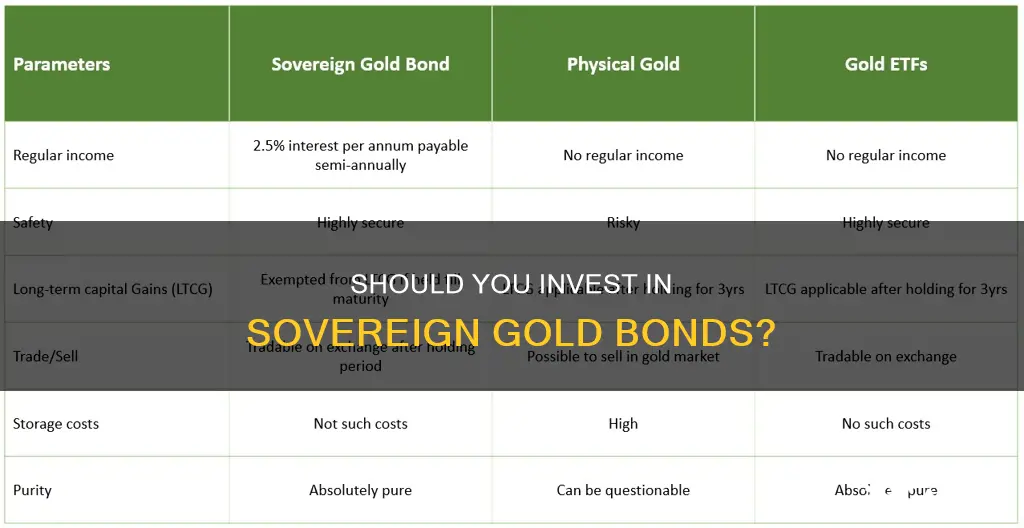
Sovereign Gold Bonds (SGBs) are government securities that are denominated in grams of gold and issued by the Reserve Bank of India (RBI). They are a cost-efficient and hassle-free alternative to investing in physical gold. SGBs are considered safe and have witnessed a significant increase in investors, with it being considered a substitute for physical gold. The interest and the principal in units of gold are guaranteed by the government, so there is no risk of default. The maturity period of the sovereign gold bond is eight years. However, you can choose to exit the bond from the fifth year.
| Characteristics | Values |
|---|---|
| Investment type | Gold bonds |
| Investment process | Simple, can be done offline or online through banking or mobile trading app |
| Investment limits | Minimum of 1 gram, maximum of 4kg per person, 20kg for trusts and other entities |
| Interest rate | 2.5% per annum |
| Interest payment frequency | Twice a year |
| Maturity period | 8 years |
| Early redemption | After 5 years |
| Taxation | Interest is taxable, no capital gains tax if redeemed after maturity |
| Risk | Default risk is low, but there is a gold price risk |
What You'll Learn

Pros and cons of investing in SGBs
Pros of investing in SGBs:
- The investment process is simple and can be done offline or online through banking or mobile trading apps.
- The interest and principal in units of gold are guaranteed by the government, eliminating the risk of default.
- Holding the bonds for the full tenure of 8 years makes the capital gains entirely tax-free, improving the post-tax yield.
- Investors can invest a minimum of 1 gram and a maximum of 4 kg per person. If there are multiple members in a family, up to 4 kg can be invested in each person's name.
- The SGB price appreciates with the price of gold, offering the benefits of owning gold without the hassle of physical storage. It is much cheaper to hold as SGBs than physical gold.
- SGBs mirror the price of gold like gold ETFs but pay an additional 2.5% annual interest on the principal amount.
- SGBs are government-backed and are safe investments.
- SGBs can be used as collateral for loans from banks, financial institutions, and non-banking financial companies (NBFCs).
- SGBs are exempt from capital gains tax if held until maturity.
- SGBs are stored electronically, eliminating the risk of loss.
- SGBs are free from issues like making charges and purity in the case of gold in jewellery form.
Cons of investing in SGBs:
- SGBs carry gold price risk. If gold prices fall, SGBs may not be profitable.
- SGBs have to be held for 8 years to be free of capital gains tax. Any holding period below that makes the capital gain taxable.
- The secondary market trading volume for SGBs is very thin, and the prices can be skewed.
- SGBs are only available in tranches, and exit is only possible when the government opens the repurchase window after 5 years.
- SGBs only accept investments and redeem in cash.
- There may be a risk of capital loss if the market price of gold declines.
- The liquidity of SGBs is lower than physical gold due to their lock-in period.
- The interest income from SGBs is taxable as per the Income Tax Act, 1961.
Rethink Robotics: Investors' Vision
You may want to see also

How to buy SGBs
Sovereign Gold Bonds (SGBs) are gold bonds issued by the Reserve Bank of India (RBI) on behalf of the Government of India. Each unit of an SGB is equivalent to one gram of gold of 999 purity. The value of an SGB is determined by taking the average closing price of gold for the three working days preceding the subscription period. These prices are published by the India Bullion and Jewellers Association Limited (IBJAL).
SGBs can be purchased in physical, digital, or dematerialized formats. Here are the steps to buy SGBs:
Buying SGBs Online
SGBs can be purchased online via some commercial banks' websites. Here are the common steps to follow:
- Log in to your preferred bank's internet banking account.
- Click on the "e-service" option and choose "Sovereign Gold Bond."
- Read and accept the terms and conditions set by the RBI.
- Complete the registration form and submit it.
- In the purchase form, enter the subscription quantity and nominee details.
- Verify the details and submit the form.
Buying SGBs Offline
If you prefer to buy SGBs offline, you can purchase them from the following entities:
- Designated post offices
- The Stock Holding Corporation of India Limited (SHCIL)
- Recognised stock exchanges in India, such as the National Stock Exchange of India Limited (NSE) and the Bombay Stock Exchange Limited (BSE)
- Scheduled commercial banks, including Karur Vysya Bank Ltd., Tamilnad Mercantile Bank Ltd., Development Credit Bank Ltd., and more
Buying SGBs Through the Secondary Market
SGBs can also be purchased from the secondary market at any time through the BSE or NSE. Buying SGBs online through the secondary market offers a discount of Rs. 50 on the nominal price.
Minimum and Maximum Investment Limits
When buying SGBs, investors should make a minimum investment of 1 gram. The maximum investment limit is 4 kilograms for individual investors and Hindu Undivided Families (HUFs), and 20 kilograms for charitable organisations, trusts, and universities.
CDs: Worthwhile Investment?
You may want to see also

SGBs vs physical gold
Gold has always been a coveted possession in India, with a strong cultural significance and a long history as a symbol of royalty and a safe investment. However, when it comes to investing in gold, there are two main options available: Sovereign Gold Bonds (SGBs) and physical gold. Here, we will compare the two and outline the pros and cons of each to help you decide which is the better investment option.
SGBs
SGBs are government securities issued by the Reserve Bank of India (RBI) on behalf of the government. They are denominated in gold, with each unit representing one gram of gold. These bonds have a tenure of eight years and offer a fixed interest rate of 2.5% per annum, paid out half-yearly. The minimum investment in SGBs is one gram, while the maximum for individuals is 4kg. SGBs can be purchased online or from banks, post offices, and authorised stock exchanges. They are a safe and simple investment option, guaranteed by the government, and do not come with the risks and costs associated with storing physical gold. Additionally, there is no TDS on SGBs, and capital gains are tax-free if held until maturity. However, one of the main downsides of SGBs is their lack of liquidity. They have a five-year lock-in period, and trading in the secondary market is possible only after that.
Physical Gold
Physical gold, on the other hand, can be purchased in the form of jewellery, coins, bars, and artefacts. It is universally accepted and can be liquidated anywhere in the world, making it highly liquid. Physical gold also gives the investor complete control over their investment, allowing them to buy and sell as they please. Additionally, physical gold is a good hedge against inflation and currency depreciation. However, one of the main downsides of physical gold is the risk of theft. It can be difficult to store and secure, especially in large quantities. There are also additional costs associated with storing physical gold, such as bank locker fees. Moreover, when selling physical gold, there may be losses due to "making charges" and a potential decrease in gold prices.
Both SGBs and physical gold have their pros and cons. SGBs offer a safe and simple investment option with guaranteed returns, while physical gold provides liquidity and complete control over your investment. Ultimately, the decision between the two depends on your financial goals and investment horizon. If you are looking for a long-term investment with guaranteed returns and don't mind the lack of liquidity, then SGBs may be the better option. On the other hand, if you prioritise liquidity and want more control over your investment, then physical gold may be more suitable.
Investing in Commodities: Why?
You may want to see also

Tax implications of SGBs
Sovereign Gold Bonds (SGBs) are tax-free if you hold them for their full eight-year tenure. However, there are some other tax implications to be aware of.
Interest Income
The 2.5% interest income from SGBs is taxable under the Income Tax Act. It is added to your total income and charged per your applicable tax slab. This interest income must be declared as "Income from Other Sources" during tax returns. There is no Tax Deducted at Source (TDS) on SGBs.
Capital Gains Tax
If you sell your SGBs before maturity, you will be subject to capital gains tax. However, if you hold the SGBs until maturity, the maturity proceeds are tax-free, and no capital gains tax is applicable.
If you sell before the completion of 36 months of investment, your gains will be charged as short-term capital gains tax per your income tax slab. If you sell after 36 months, you can choose to be taxed as per the Long-Term Capital Gains (LTCG) tax, with or without indexation benefits.
Securities Transaction Tax (STT)
If you sell your SGBs on a stock exchange, securities transaction tax (STT) is also applicable.
Demat Account Holding Fee
If you hold SGBs in dematerialized form, you may have to pay a nominal demat account holding fee to depositories to maintain and manage the SGBs.
Investing: Wealth and Security
You may want to see also

SGBs as collateral
Sovereign Gold Bonds (SGBs) can be used as collateral for loans from banks, financial institutions, and Non-Banking Financial Companies (NBFCs). The loan-to-value ratio is the same as that of ordinary gold loans prescribed by the Reserve Bank of India (RBI). The granting of loans against SGBs is subject to the bank or institution's decision.
The minimum loan amount per individual is Rs 20,000, with a maximum of Rs 20 lakhs. The margin requirement is 35% of the market value of SGBs. The interest rate for loans against SGBs is typically lower than that of other loans, and the loan is usually sanctioned on the same day of application.
SGBs can also be pledged for collateral margin at certain institutions, such as Zerodha, if they are on the list of approved securities for pledging. Assuming a 10% haircut, for every ₹100 worth of SGBs pledged, a collateral margin of ₹90 will be received. It is important to note that interest on the SGBs will continue to be received even if they are pledged.
The eligibility criteria for availing of loans against SGBs include being a resident of India, being above 21 years of age, and having a steady source of income. The SGBs must be held in dematerialized form with any depository participants, as loans against SGBs held in physical form are typically not permitted.
The use of SGBs as collateral provides individuals with an alternative to buying physical gold for the purpose of collateral. It reduces the overall cost of credit and serves as an incentive for those who buy gold as a safety net.
Jio: India's Digital Revolution
You may want to see also
Frequently asked questions
SGBs are a great way to invest in gold without the hassle of physical ownership. They are also a good hedge for your overall portfolio during tough times. There is no risk of default as the principal in gold units and the regular payment of interest are guaranteed by the government. SGBs offer tax-free capital gains if held for the full tenure of 8 years.
SGBs carry gold price risk. If the gold price declines, investors stand the risk of losing their invested capital. There is also a long lock-in period of 8 years, with limited secondary market liquidity.
According to the scheme, Indian residents as defined under the Foreign Exchange Management Act (FEMA), 1999, can invest in SGBs. This includes individuals, HUFs, trusts, universities, and charitable institutions.







